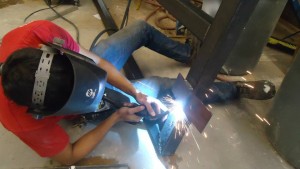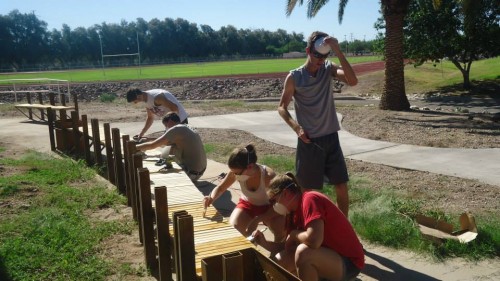
William Ruoff felt that he wasn’t getting enough hands-on experience from classes at the University of Arizona when he decided to join the American Institute of Architecture Students Freedom by Design.
Freedom by Design is a non-profit community outreach program within the UA College of Architecture, Planning and Landscape Architecture that helps people with disabilities living in the Tucson community.
“I think it’s important to help your community,” said Ruoff, 21, a fourth year architecture major. “You’re kind of in this small space on campus and you never really understand what’s going on socially outside of the campus, so it’s a great way to go out there and try to change the community that you’re spending so much time around.”
According to rankings by the Corporation for National and Community Service, a federal agency that helps people improve the lives of others through volunteering, college student volunteer rates in Arizona went from 27.7 percent in 2011 to 30.9 percent in 2012.
Over the years Freedom by Design members have designed and built ramps, a common room for the Arizona State Schools for the Deaf and the Blind, and this year’s project has them working on a reception desk for Literacy Connects – a non-profit organization that helps people learn how to read and write.
AIAS has Freedom by Design chapters all over the U.S. but according to Amanda Schwarz, UA AIAS president and fourth year architecture student, the UA chapter is one of the most active.
“A lot of Freedom by Design programs produce ramps every now and then but this one has really grown over the past year or two,” Schwarz, 21, said. “They’ve completed a number of projects that really help it stand out among all other chapters in the country.”
Arizona State University has a Freedom by Design chapter of its own, which was led by Marissa Mendoza for the past two years. Mendoza, 23, is now the vice president of AIAS at ASU.
For Mendoza, her motivation to join was the potential to learn as a leader and grow as a designer. They also had some obstacles to overcome because there was, “a big learning curve” according to Mendoza.
It was the first time they had to actually build something they had designed; it wasn’t speculation anymore, she said.
Another reason that architecture students are motivated to volunteer is that they get more opportunities to experience the technical side of architecture.

“Freedom by Design is one of the few outlets in the school where you can actually hold a hammer or go out and pour concrete,” said Ruoff, director of Freedom by Design.
The rate of volunteerism has increased substantially on the ASU campus, according to Michelle Lyons-Mayer, adviser for Changemaker Central, a student-run initiative that hopes to increase student involvement in the community.
Last year they learned that ASU students were engaged in more than 770,000 hours of service and Lyons-Mayer, 49, thinks that it’s “just the tip of the iceberg.”
In order to keep track of the student volunteer hours, ASU has started using VolunteerMatch, which is one of the widely used databases by non-profits, and it helps students find volunteer opportunities in their area.
The goal for this year is to document more then 800,000 hours of service, said Lyons-Mayer.
One notable point of growth has been their Devils in Disguise event, which is a one-day service event that provides student volunteers to a number of different non-profits.
Two years ago they had about 950 students participate in that event. Last year that number grew to more than 1,600 students and this year they have set a goal of more than 2,000 students volunteering on a single day.
Bryan Namba, executive director of VolunteerUA, sees an increase in volunteerism among college students, but he thinks there’s still a lot more work to do.
“I think it’s great that people are really into volunteering and I think a lot of people underestimate the important of it,” Namba, 22, said. “Not only for the standpoint of helping the community but also for helping yourself because volunteering provides you with real world experience and work experience.”
VolunteerUA connects the campus with the community and organizes events for non-profits to recruit volunteers and spread the word about their organizations.
Its focus is built on bridging the gap between UA and the Tucson community.
Northern Arizona University also has a Civic Service Institute, which oversees different volunteer programs. Deirdre Crawley, 58, is the assistant director.
Crawley said that volunteerism at NAU is very strong and a lot of the students see the value in volunteering and being engaged with the community, but she also sees room for improvement.
Students at NAU are looking for more volunteer opportunities, Crawley said. They are getting more and more calls at their office, with students asking for help on finding a way to volunteer.
“We have a strong service learning component with many of the classes,” she said. “Freshmen come in and lots of their classes are geared towards a service learning component to the freshman coursework that they’re involved in.”
The College of Medicine at UA also has programs that are geared towards learning from service.
One example is the Commitment to Underserved People program, which aims to connect medical students to the Tucson Community by giving educational talks or providing medical services to people who can’t otherwise access health care.
Carlos Gonzales, associate professor in the College of Medicine, created the program when he was a medical student at UA in 1979.
“At that point there was no volunteer program at all, and one of the reasons my cohort, there was about eight or 10 of us, decided to develop the program because we felt we needed to do something besides go to school,” said Gonzales, 59.
Right now, 90 – 95 students out of 115 a year participate in the program.
Ricardo Valerdi, associate professor in the College of Engineering, is the founder of a program that also aims to bridge the gap between middle school children and math and science, using baseball.
The Arizona Science of Baseball program is a partnership with the Arizona Diamondbacks, and they use baseball to teach children about science, technology, engineering, and math. Volunteers in the program are made up of engineering students at UA.
“I think students at the University of Arizona are lucky and very fortunate to be here and they get to give some of that back to the community through programs like these and other volunteer opportunities,” said Ricardo, 37.
Austin Masterson, a junior in mechanical engineering, is one of the students who volunteers in the program.
Masterson, 20, joined the program because he wanted his work to benefit children and help direct them toward a degree or a career in science and math.
Valerdi said he thought students were more inclined to volunteer when the program involved something they were interested in and was a part of their major.
Giau Le, a third year graduate audiology student, is the president of the Student Academy of Audiology at UA.
“I would like to believe that I would volunteer regardless of my major,” said Le, 24. Volunteers conduct free hearing screenings, and some counsel members of the community about hearing loss.
“I think it’s important for students like myself to volunteer because it feels good to be able to use the knowledge you have learned in the classroom to improve someone’s life,” she said. “I also think volunteerism allows you to get to know people, who you may have otherwise just passed on by.”
Brad Lang, a lecturer at College of Architecture, Planning and Landscape Architecture, is the faculty advisor for AIAS and believes students want to be out in the community and want to be giving back.
“Very rarely do I come across a student who’s like, ‘That sounds like too much work’ or ‘Oh I have a party to go to,’” said Lang, 37. “It’s usually, ‘Tell me more about these opportunities and how can I pursue them?’”
Lyons-Mayer at ASU said she thinks students are frustrated by the stereotypical image of college students who are only interested in drinking and partying – especially the students who are involved in the community.
“We want to do a better job of showcasing how many students are doing service because we know there’s a culture of service here but we want the broader community to know that as well,” she said.
Reham Alawadhi/Arizona Sonora News Service


